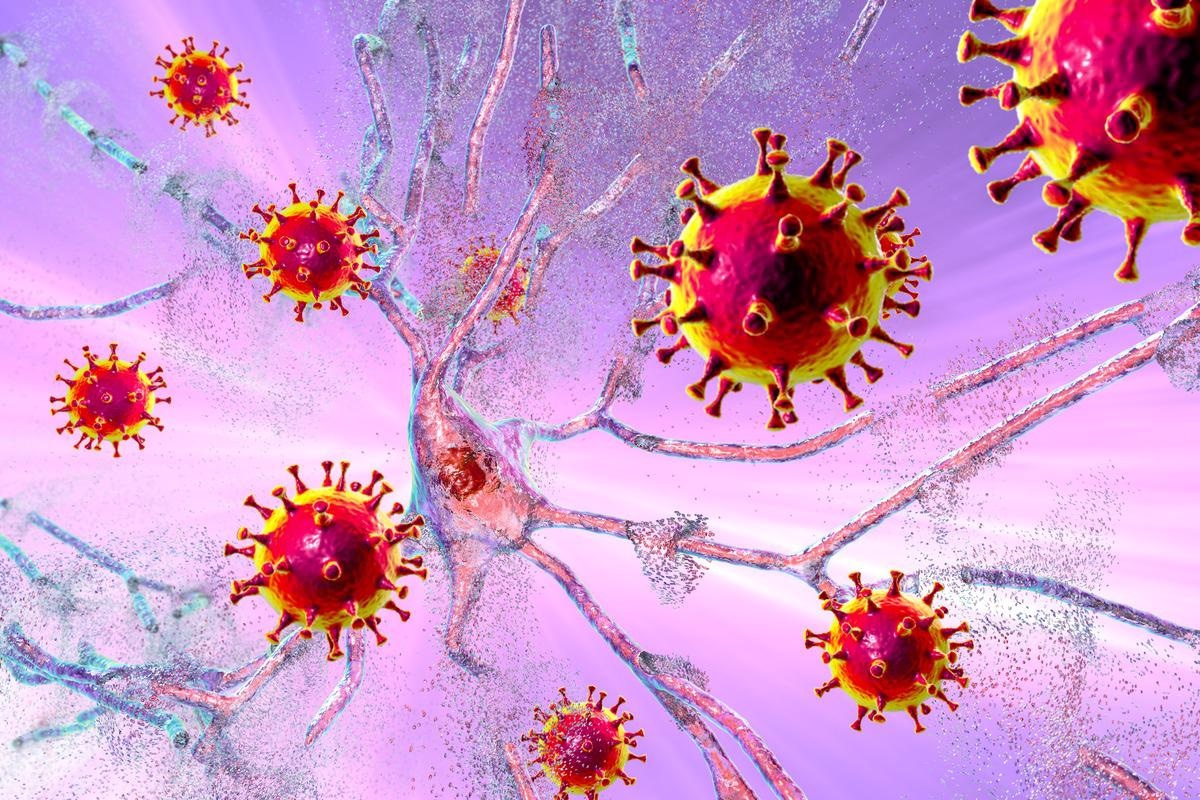In a recent study posted to the medRxiv* pre-print server, a team of researchers examined the neurotoxic damage to the brain’s cortical region in patients hospitalized due to coronavirus disease 2019 (COVID-19).
 Study: Brain cortical changes are related to inflammatory biomarkers in hospitalized SARS-CoV-2 patients with neurological symptoms. Image Credit: Kateryna Kon/Shutterstock
Study: Brain cortical changes are related to inflammatory biomarkers in hospitalized SARS-CoV-2 patients with neurological symptoms. Image Credit: Kateryna Kon/Shutterstock
Several research studies have examined chronic neuronal dysfunction and hyperinflammatory responses in patients infected with severe acute respiratory syndrome coronavirus 2 (SARS-CoV-2). However, studies have not assessed these neurological symptoms and related neurological complications, observed in 80% of hospitalized COVID-19 cases.
About the study
In the present study, researchers assessed several neurological symptoms and their linkage with clinical indicators of inflammatory processes in hospitalized COVID-19 patients. They selected the Desikan-Killiany atlas, having 33 cortical regions per hemisphere, and studied its gray matter volume (GMV) (cm3), thickness (Th) (mm), and surface area (SA) (mm2) characteristics.
They screened 33 patients at Basel University hospital who participated in a multicenter, cross-sectional study between August 2020 and April 2021 and were 18 years or older. As controls, age- and sex-matched healthy individuals having the same image protocol were recruited from the Neurology Department, University of Basel. The researchers used a linear regression model to compare cortical measures between the study and the control groups.
The researchers performed high-resolution three-dimensional (3D) longitudinal relaxation time-weighted (T1w) magnetic resonance imaging (MRI) sequencing of the brain of all the eligible participants; additionally, a subset of participants underwent cerebrospinal fluid (CSF) sampling. The laboratory tests included leukocytes, lactate, protein levels, CSF-blood/albumin-ratio, and five cytokines (plasma-tumor necrosis factor-related activation-induced cytokine (TRANCE), plasma-receptor for advanced glycation end-products binding protein (EN-RAGE), CSF-osteoprotegerin (OPG), CSF-TRANCE, and CSF-EN-RAGE). The researchers performed cytokines analysis using the Olink 96 target inflammation and neurology panels.
They employed the FreeSurfer-6.0 image analysis suite for the Th and GMV segmentation of each anatomical T1w magnetization-prepared rapid gradient-echo (MPRAGE) image, taken using MRI scanners. The study covariates were gender, age, age*gender, total intracranial volume/mean Th/total SA, and MRI magnetic field strength.
The researchers used partial correlation with adjustments to the same covariates to examine the potential links between cortical features and laboratory variables; further, they used false discovery rate (FDR) for p-values adjustments.
Findings
Based on their neurological symptoms, there were three classes of study participants – class I, class II, class III, having mild, moderate, and severe neurological symptoms, respectively.
The authors noted a lower GMV in cingulate and orbitofrontal cortical regions in some of the hospitalized SARS-CoV-2 patients; similar to previously reported multifocal MRI abnormalities in the hospitalized SARS-CoV-2 patients. More specifically, a lower GMV was observed in the right rostral anterior cingulate, left medial orbitofrontal, and left superior frontal regions with patients-mean of 0.38, 0.84, and 3.75, respectively. Intriguingly, GMV was consistently negatively associated with protein levels, CSF/blood-albumin ratio, and CSF EN-RAGE.
After FDR correction, the patient cohort and the healthy controls showed no significant differences between Th and SA values. In the subset of patients considered for the CSF study, blood leukocytes were negatively associated with GMV in the right lateral orbitofrontal and left inferior temporal regions.
As hypothesized, the brain alterations after SARS-CoV-2 infection is a neuroinflammatory response. The results confirmed increased CSF levels of indirect inflammatory markers, including protein, blood/albumin ratio, and EN-RAGE.
In 18 regions localized in the frontal, orbitofrontal, and temporal lobes of the brain cortex, the authors observed the highest number of negative correlations for protein levels. Of these proteins, CSF/blood/albumin-ratio and the EN-RAGE cytokine showed negative correlations in 15 and 17 cortical regions, respectively.
The CSF/blood/albumin-ratio showed a positive correlation with left rostral anterior cingulate, left lateral orbitofrontal, and right paracentral region of the brain cortex with p-values of 0.03, 0.02, and 0.04, respectively. However, it negatively correlated with the left rostral anterior cingulate and right caudal middle frontal. Further, EN-RAGE showed a positive correlation with the left pars triangularis with a p-value of 0.002. Likewise, SA showed a significant correlation between the EN-RAGE and the right posterior cingulate cortex with a p-value of 0.04.
The relationship between ENRAGE, a cytokine that activates an inflammatory cascade, and CSF/blood-albumin ratio with increased volumes in some cortical areas suggested a SARS-CoV-2-triggered inflammatory process due to a secondary parainfectious complication or after a less probable direct invasion.
Additionally, the authors noted a significant association between a decreased GMV and Th in the frontal, frontal-orbital, and temporal lobes of the brain’s cortex of hospitalized COVID-19 patients.
Conclusion
To conclude, the study demonstrated an association between CSF inflammatory marker levels and GMV and Th changes in frontal, orbitofrontal, and temporal regions in hospitalized SARS-CoV-2 patients exhibiting different levels of neurological symptoms. The authors suggested that their findings be confirmed and expanded in future longitudinal studies in larger cohorts.
*Important notice
medRxiv publishes preliminary scientific reports that are not peer-reviewed and, therefore, should not be regarded as conclusive, guide clinical practice/health-related behavior, or treated as established information.
- Gretel Sanabria Diaz, Manina Maja Etter, Lester Melie Garcia, Johanna Maria Lieb, Marios-Nikos Psychogios, Gregor Hutter, Cristina Granziera. (2022). medRxiv. doi: https://doi.org/10.1101/2022.02.13.22270662 https://www.medrxiv.org/content/10.1101/2022.02.13.22270662v1
Posted in: Medical Research News | Medical Condition News | Disease/Infection News
Tags: Albumin, Blood, Brain, Chronic, Coronavirus, Coronavirus Disease COVID-19, Cortex, covid-19, Cytokine, Cytokines, Glycation, Hospital, Imaging, Inflammation, Laboratory, Magnetic Field, Magnetic Resonance Imaging, Necrosis, Neurology, Protein, Receptor, Research, Respiratory, SARS, SARS-CoV-2, Severe Acute Respiratory, Severe Acute Respiratory Syndrome, Syndrome, Tumor, Tumor Necrosis Factor

Written by
Neha Mathur
Neha Mathur has a Master’s degree in Biotechnology and extensive experience in digital marketing. She is passionate about reading and music. When she is not working, Neha likes to cook and travel.
Source: Read Full Article
